DEVELOPMENT OF ALGORITHMS FOR PROCESSING 3D OBJECTВ FOR MOBILE PLATFORMS
INTRODUCTION
In today's device-based mobile platforms are becoming more common. This is due to the need of modern man to be always connected. But if ten years ago the mobile phone was just a communication tool - the mobile version of a stationary vehicle, five years ago, he could serve as a notebook, helping to share small amounts of information and could be used as a means of entertainment. Now the concept of a mobile phone embedded unusually wide range of functions. With the help of a modern mobile phone, which belong to the middle-price category, you can take high quality pictures and videos, receive, store, reproduce and transmit large amounts of data, use the Internet and play games on the quality and detail that even a decade ago could not dream and owners of desktop computers. This work will be performed for high-performance mobile phones, also known as smartphones. They are more transportable than laptops, and many of them have comparable functionality.
Smartphone has the following hardware features:
- the larger screen makes it easy to work;
- the processor, whose frequency provides greater performance;
- graphics card, which allows processing of large volumes of multimedia
content without booting the main processor;
- working memory, which allows to operate large amounts of data;
- a significant amount of internal memory, as well as the ability to connect additional
modules;
- additional modules such as Wi-Fi, GPRS and so on
URGENCY
We must recognize that the basis for development of desktop and mobile performance are computer games and applications that use three-dimensional graphics. An increasing number of such applications are adapted for use in mobile devices, which entails meeting specific requirements, one of which is to reduce the amount of memory to represent the three-dimensional models used in applications. Thus, the theme of work aimed at adapting the three-dimensional models for use in smartphones, is relevant.
PURPOSE AND OBJECTIVES
The purpose of this research is to develop a student's adaptation algorithm of three-dimensional models for use on mobile platforms.
To achieve the purpose will be to solve the following problem:
- perform a comprehensive comparative analysis of existing algorithms for optimization
of three-dimensional models;
- develop an algorithm to adapt to the conditions of three-dimensional models of mobile platforms;
- develop an application that will automatically detect the hardware capabilities of the device, accept
the terms of optimization of the user, and then bring the model to the required parameters;
- perform testing and testing of proposed solutions.
Alleged scientific innovation consists of a comprehensive comparative analysis of existing algorithms for optimization of three-dimensional models and their adaptation to the mobile platform.
The practical valueof this work is to develop an application that can adapt itself to the three-dimensional model of the device that is using resources and building on the characteristics of the mobile platform.
OVERVIEW OF EXISTING MOBILE PLATFORMS
Nowadays there are a number of mobile platforms, the main of which are listed below:
- Windows Phone (Windows Mobile) - the operating system for mobile devices with the basic set of
applications, such as the Windows Marketplace for Mobile, My Phone, Windows Live, based on
the Microsoft Win32 API [1];
- Android - an operating system for mobile phones and smartbooks based on the kernel Linux.
Originally developed by Android Inc., which was then bought Google [2];
- Simbian, developed by a consortium Symbian, founded in June 1998 the Company: Psion, Nokia,
Ericsson and Motorola. Later the company joined the consortium: Sony Ericsson, Siemens, Panasonic,
Fujitsu, Samsung, Sony и Sanyo [3];
- IPhoneOS (iOS) - developed by Apple and is a very special product. Its main decision was laid in the
first iPhone: it's smooth scrolling, capacitive screens multi-touch [4].
Windows Phone (Windows Mobile)
The following are the main features of the OS family of Windows Mobile:
- flexible configuration of virtually any parameters;
- support to the interface;
- installation of third party software.
Design OS like Windows, but it has nothing to do with the desktop version. This operating system contains many features, among which the following information: the messaging (SMS, e-mail), media player, Internet Explorer, calendar, notes and address book. A characteristic feature of this platform is an open architecture that allows you to install additional programs and execute add-ins for standard programs.

Smartphone Windows Mobile
For the platform presented a great number of third-party software: business applications, alternative browsers, software for ICQ, reading books, calculators, multi-media players and more, but the list of quality games is not as extensive [1].
Simbian
On the side of Symbian user-friendliness, which is not technically prepared. Symbian operating system can be divided into two major subgroups: Series 60 (as well as additional options - S80 and S90), UIQ with a touch screen and is used by SonyEricsson.

Smartphone based on Simbian
The family of Symbian UIQ. Generation operating systems UIQ (User Interface Quartz) is designed for smartphones with a touchscreen and differs from the S60 for the most part is a graphical environment. This platform is used on smartphones Sony Ericsson, the version currently in use - UIQ 3.0, which is based on Symbian 9.1. [4]
Android
The breadth of opportunities the Android platform is not inferior operating system desktops. It is multilevel environment based on Linux kernel and has a rich functionality . The basis of the user interface are:
- windows;
- submissions;
- to display the common elements such as editable fields, list sand lists of developable.

Smartphone based on Android
Android solves the problem of graphics with built-in support for 2-D and 3-D graphics, including a library OpenGL. The problem of storage is simplified thanks to the Android platform in the popular database open source SQLite. [9]
iPhoneOS (iOS)
iPhone OS is based on a special version of Mac OS X, while the interface is adapted for use with your fingers. Feature of the device is a large touch screen, which occupies almost the entire front panel and only one key, all management is done by touch and move your finger across the screen which makes it a smartphone, as it were alive.

Smartphone based on iPhone OS
The smartphone is based on the ARM processor, 620 MHz, screen resolution of 480x320, supported GSM850/900/1800/1900, Wi-Fi, Bluetooth 2.0 + EDR, EDGE, 2MP camera, Li-Ion Battery 8:00 razgovora/250 hours of standby, sizes 115h61h11, 5mm, weight - 135 g.
Standard functionality includes basic phone features.
- call, conference calls, no voice control, the main feature - visual voicemail, which works with U.S.
carriers, you can manage voice mail messages directly into the phone interface;
- SMS is implemented in the form of dialogue;
- Ring tones are sold in the iTunes Store, in the normal ringing is not provided,
but will work when using third-party software;
- Multimedia player resembles that of the iPod, but knows how much more, and large screen allows
you to watch movies with high quality;
- Internet is possible thanks to EDGE and Wi-Fi, as well as built-in browser Safari. There is no
technology Flash, however, is the fastest browser among all mobile devices;
- Operating System Mac OS offers in the future, the ability to easily portprograms for the Macintosh
on the iPhone. [4]
OBJECT OF RESEARCH
Objects of research are the algorithms and methods for optimizing three-dimensional models. To carry out research as a hardware base selected mobile devices, the company Apple. The model will be developed in an environment 3DS max and then exported to the mobile device. Then export the model to adapt to the conditio ns of use and performance of the device.

CONCLUSIONS
1. A review showed that mobile platforms are a significant part
of the modern variety of computer equipment. In this significantly development received
applications using three-dimensional models.
2. An important aspect of adapting applications for mobile platforms
is to optimize the three-dimensional models.
3. Optimization model can be performed directly on the device, given the available
hardware resources.
REFERENCES
1. Обзор платформы Windows Mobile - http://gamesmart.at.ua/publ /obzor_mobilnykh_os_platform
/obzor_platformy_windows_mobile/2-1-0-10
2. Обзор платформы Android -http://gamesmart.at.ua/publ/obzor_ mobilnykh_os_platform/obzor_
platformy_android/2-1-0-9
3. Обзор платформы Symbian - http://gamesmart.at.ua/publ/obzor_ mobilnykh_os_platform/obzor_
platformy_symbian/2-1-0-8
4. Умные карманные помощники. Часть I – мобильные операционные системы - http://www.
hpc.ru/libarts/2472/1.shtml#b20
5. Мобильные платформы – прошлое, настоящее и будущее -http://mobilexp.info/articles/461
6. Википедия Apple iOS - http://ru.wikipedia.org/wiki/Apple_iOS
7. Best of Q2 - part 3 - http://usa.blog.nimbuzz.com/2010/07/12/best-of-q2-part-3/
8. HTC EVO — первый в мире Android Phone - http://readmas.ru/tag/android- phone
9. Введение в разработку для платформы Android - http://android-club.com.ua/?articles=15
10. Здзиарски Джонатан, iPhone Разработка приложений с открытым кодом - Санкт-Петербург:
БХВ-Петербург, 2009, 386 стр.
11. Садыков С.С., Захаров А.А., Выбор уровня детальности при непрерывном упрощении
поверхностей полигональных объектов – Вычислительные методы и программирование, 2003.




